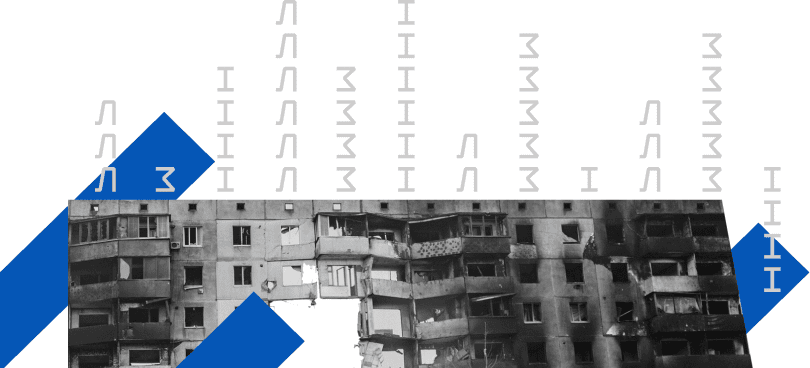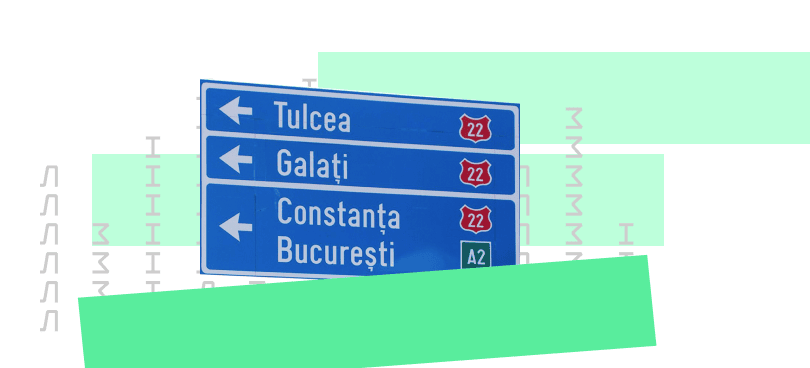ALI Article for the “Decentralization” portal
There are ongoing discussions about reconstruction, recovery, and development of regions and communities, devising recovery plans and priority areas of recovery at the level of government, in the expert environment and in the public domain. These issues have been on the agenda since the beginning of russia’s war against Ukraine, i.e., since 2014. Even then, Ukraine was forced to restore settlements that had been destroyed by russia.
The state policy of territory recovery for 2014–2022 may be characterised by gradual improvement. Notably, approaches shifted from solely reconstructing infrastructure facilities and implementing temporary projects to developing planning documents that comprise clearly defined objectives for the advancement of communities. Obviously, there are several objective reasons for the gradual systematisation of the recovery policy, which did not take place immediately:
- changes in the political situation following the Revolution of Dignity and the course towards the EU;
- the commencement of a series of reforms, including the decentralisation reform;
- lack of certain experience in waging the war and temporary occupation of territories;
- lack of experience in systematic cooperation with international partners.
At the same time, the restoration of de-occupied communities is a long process. Throughout these years, we were unable to establish a systematic and lucid state policy for the restoration of regions and communities. So, what is happening now with the restoration of communities, and what needs to be considered?
The research done by the Agency for Legislative Initiatives (ALI) shows that there were two main coordination and regulatory problems that existed even before the full-scale invasion. Today, just like in 2014, plans, strategies, and programs are being developed, in particular, at the community level. Laws governing the recovery processes are being adopted. Just as before the full-scale invasion, the ministries are undergoing a restructuring process, as evidenced by establishing of the Ministry for Reintegration of the Temporarily Occupied Territories. After the full-scale invasion, two ministries were merged into a single Ministry for Communities, Territories and Infrastructure Development of Ukraine to improve the coordination of recovery efforts. Indeed, efforts to restore communities are underway, but there are still several challenges.
There are two competing documents in the regulatory part of the recovery policy. On the one hand, there is the Law of Ukraine, “On the Principles of State Regional Policy,” which systematizes the levels of state regional policy documents: state strategy, regional strategy, and territorial community development strategy. A recovery and development plan is being introduced for the territories affected by russian aggression (for the regions and for the community). The Resolution “On Approving Procedures for the Restoration and Development of Regions and Territorial Communities,” which was developed based on the law, states that the draft plan for the restoration and development of a territorial community should be devised with a comprehensive restoration program in mind, if the community meets the following criteria: 1) over 15% of the housing stock of the territorial community or individual settlements is destroyed and/or damaged; 2) the population has changed by more than 25%; 3) the decision to develop a comprehensive recovery program was made following the statutory procedure. Hence, under the by-law regulation, the Program is needed to prepare the Recovery Plan. However, under the Law “On Regulation of City Planning Activity,” the Comprehensive Recovery Program is not mandatory. Consequently, we have two effective laws that contradict each other.
Furthermore, the Resolution mentioned above of the CMU contains inconsistencies both in determining of areas to be restored and in the plan development, resulting in contradictions. To be considered for recovery, communities need to meet one of these conditions: 1) there were hostilities in the community territory; 2) the community or part thereof was temporarily occupied; 3) destruction of critical infrastructure and housing stock resulting from hostilities and shelling; 4) population decline (15%); 5) increase in the unemployment level (15%); 6) reduced taxes revenues to local budgets (15%); 7) the share of IDPs in the community makes up more than 10%. Communities are granted a period of one month to prepare justifications concerning the assessment of compliance with one or another criterion. However, in such circumstances, communities are unable to swiftly and objectively ascertain their affiliation with the recovery territories. The first two criteria (the existence of hostilities and/or temporary occupation) should not pose any difficulties, as the lists of such territories are approved by a separate resolution of the Ministry of Reintegration. However, there will be difficulties in determining the number of residents since it is necessary to carry out calculations, which can be a lengthy and sometimes impossible process. Also, the register of IDPs does not show the exact number of displaced people because not all of them are registered in the respective communities and can move freely to other territories after they are registered. Therefore, the accuracy of this metric is doubtful.
Furthermore, after the creation of the list of restoration areas, the assessment of compliance with the criteria ought to be conducted by a commission comprised of representatives of the line ministry (50%) and the line committee of the Verkhovna Rada (50%). The commission is likely supposed to perform a formal oversight function and ensure transparency, but unclear criteria may create the risk of political influence and delaying tactics. Furthermore, the absence of representatives from specialised associations and public associations in the commission raises concern. On the other hand, the defined criteria do not have any measurable indicators of their effect on the community and the need to recover a certain object. Therefore, the question is about the risks of restoring all objects without exception, even those where the use of funds is irrational, like it was in 2014.
Another aspect of the issue is coordination. The findings of the ALI study indicate that local governments require improved coordination of recovery procedures. Community representatives expressed reservations regarding the merger of ministries into a single Ministry for Communities, Territories, and Infrastructure Development, as it resulted in staff turnover and prompted apprehensions regarding the loss of working relationships and close communication with Ministry representatives.
Furthermore, to enhance the coordination of the recovery policy, it is essential to involve various ministries from different ministries, which currently lacks proper regulation. According to stakeholders, the lack of coordination between institutions and departments at the central government level impedes recovery procedures in the communities and significantly delays the decision-making process.
To accomplish this, it is imperative to establish a comprehensive national recovery policy that encompasses clear indicators and guidelines for communities. Each ministry must realise the significance of its role in the recovery process and the assistance it can offer to communities. Hence, according to stakeholders, it is recommended to devise a standardised aid package that considers the government’s capacity to cater to requirements in various domains, including but not limited to infrastructure projects, education, healthcare, social services, and so forth. This will allow for optimising the communication and contributing to addressing primary recovery objectives in the shortest time possible.
According to community representatives, the role of central authorities in the recovery system is the following:
- coordinating recovery processes – promoting community communication with charities and international partners;
- developing state policies with determined indicators and metrics;
- monitoring the completion of the Register of Damaged Property;
- developing the required regulatory acts to ensure the recovery process, including communicating with communities concerning the elaboration of regulatory acts;
- developing methodological resources on community recovery;
- accumulating resources and facilitating the funding of recovery projects.
With the lack of coordination, communities face the issue of prioritisation of recovery domains and planning. Frequently, communities addressed issues on a case-by-case basis. Even though, according to respondents, developing planning documents is an essential part of figuring out long-term tasks, representatives of the local government (LG) and military administrations (MA) face many problems during their preparation, inter alia:
- lack of qualified staff and relevant experience in drafting planning documents;
- lack of defined national policy (e.g., on IDP and refugee return, determining types of territories with special conditions, such as the level of destruction, proximity to the border with the rf, low population density, etc.);
- inability to calculate basic indicators to determine communities’ social and demographic structure.
Furthermore, stakeholders emphasised the importance of distinguishing between national and local issues related to recovery, which will be outlined in the national strategy and the strategies of territorial communities. It is crucial that the national strategy approves the unified goals of state policy and that specific steps for developing the territorial community are developed in various sectors in accordance with these goals. For example, at the national level, a security component is defined for border territories, and specific measures are formulated in those communities according to needs and available resources.
Furthermore, the national strategy should be developed with communities, as this is a framework document. The inability to grasp the national recovery vector and the lack of capacity to identify the community’s actual needs significantly impede strategic planning processes.
Conclusions and Recommendations
Restoring de-occupied communities is a durable process which requires all political actors to work together and interact with communities as much as possible. Since 2014, there have been regulatory and coordination problems, but the damage and consequences of military actions were much smaller.
Hence, to ensure the efficient development and implementation of the recovery policy for regions and communities, it is imperative to consider the following measures:
- Systematise norms of the laws “On the Principles of State Regional Policy” and “On Regulation of City Planning Activity” in terms of developing Comprehensive Recovery Plans.
- Establish a recovery plan as a crucial component of the strategies and regulate the possibility of modifying the planning documents for regions that are consistently being damaged due to hostilities.
- Determine a national recovery policy regarding the return of IDPs and refugees; determine which settlements are not subject to reconstruction in the short term; restore and develop territories with special conditions (such as proximity to the russian federation, low population density, etc.).
- Establish a standard method for calculating quantitative indicators for predicting the population structure and socio-economic growth of communities to establish priority restoration projects in various domains.
- Improve communication between the central executive power and community representatives in the context of preparing strategies and providing methodological resources. This is particularly necessary for the implementation of recovery measures that are tailored to community needs and the formulation of strategies that adhere to a unified standard principle.
- Elaborate educational programs to enhance local government representatives’ qualifications and arrange expert advisory assistance, such as establishing a separate advisory body within communities. After all, as noted by LG representatives, the communities lack personnel able to prepare planning documents.
- Determine the internal audit and control system at all stages of recovery project implementation. The control mechanism will allow for responding proactively and identifying the issue timely.
The text has been prepared as part of the “Civil Society for Ukraine’s Post-Ware Reconstruction and EU-Readiness” Project, which is implemented with financial support from the EU.















